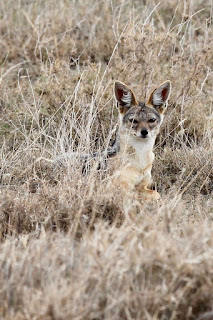After a nice breakfast, we went on another game drive in the Tarangire National Park. We saw more elephants, gazelles and a large group of baboons. Augustine tried to drive along the river to spot lions, however, we did not have any luck.
On our way to the Serengeti National Park in the afternoon, we drove through the Ngorongoro Conservation Area which is a protected area and a World Heritage Site located 180 km (110 mi) west of Arusha in the Crater Highlands area of Tanzania. The area is named after Ngorongoro Crater, a large volcanic crater within the area.
The road to the Senergeti National Park is unpaved just like all roads in Tanzania’s national parks. It was a bumpy ride on narrow and dusty road. However, we did witness the coexistence of human, livestock and wildlife in this area.
After we got to Serengeti National Park, Augustine told us that “Serengeti” means “an endless plain” in Maasai language. At the entrance of the park, we can see why it is called Serengeti National Park.
We spotted elephants, giraffes, and a lot of gazelles on the road side. We even spotted a lion just laid along the road side with a jackal checking out on her nearby. This was the first lion we saw, therefore we stayed for quite a while and took a lot of pictures. We also spotted a cheetah in distance.
After we got to Serengeti National Park, Augustine told us that “Serengeti” means “an endless plain” in Maasai language. At the entrance of the park, we can see why it is called Serengeti National Park.
We spotted elephants, giraffes, and a lot of gazelles on the road side. We even spotted a lion just laid along the road side with a jackal checking out on her nearby. This was the first lion we saw, therefore we stayed for quite a while and took a lot of pictures. We also spotted a cheetah in distance.
Augustine told us on how to tell differences among impala, Grant’s gazelle and Thomson’s gazelle. They are commonly seen in this area of Tanzania.
Impalas have long neck with a smooth short coat of reddish-brown, white underparts. The males carry magnificent, wide-set, u-shaped horn that curve backwards, sideways then upwards. The female is smaller than males and lacks horn. Impalas eat grass and leafs, therefore they don't participate the great migration.
Grants’ gazelles are large gazelles stand 65 inches high and can weight up to 147 pounds, with pale brown coats and a white patch above their tails. Both males and females have horns. They participate in the great migration.
Thomson’s gazelles are most seen in Serengeti with light brown coats, dark stripes on their sides, and white patches just above the tail. They stand up to 26 inches high at the shoulder and can weigh up to 55 pounds. Male Thomson's gazelles have horns, while females have much smaller horns. Their diet consists of grass and seeds, and they are hunted by a variety of predators, including cheetahs, leopards, lions, and hyenas. Gazelles eat grass only, so they do participate in the great migration.














No comments:
Post a Comment